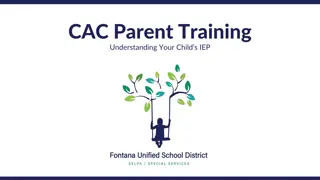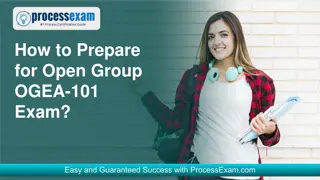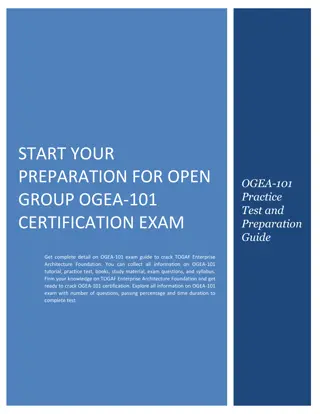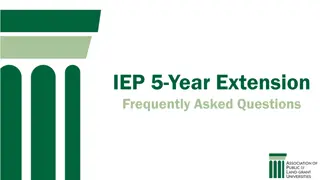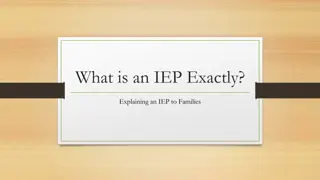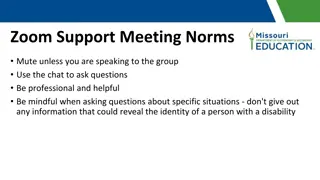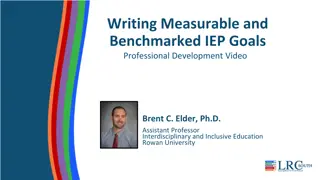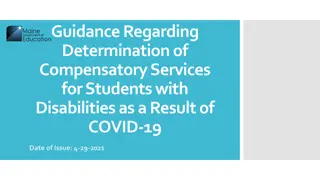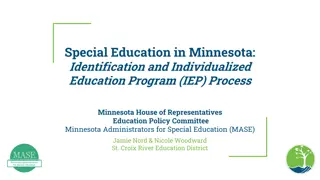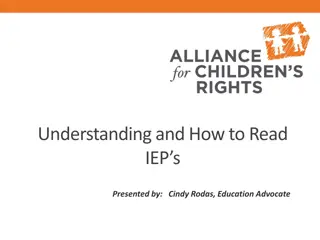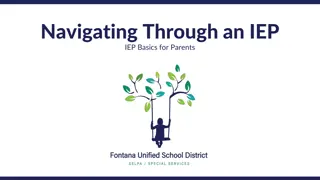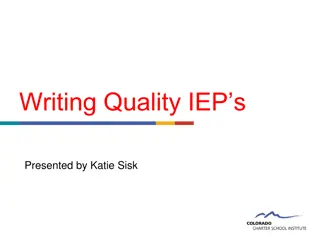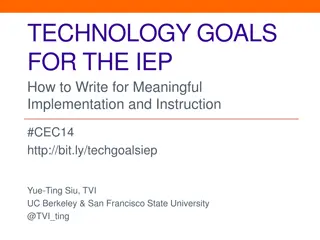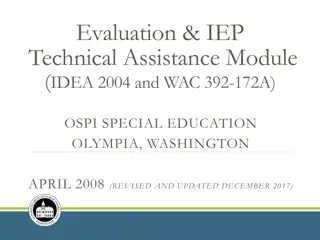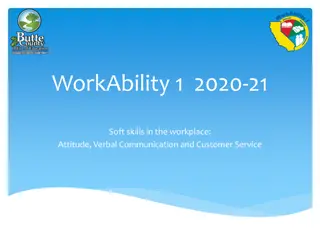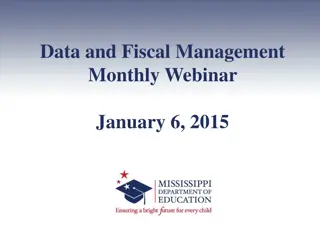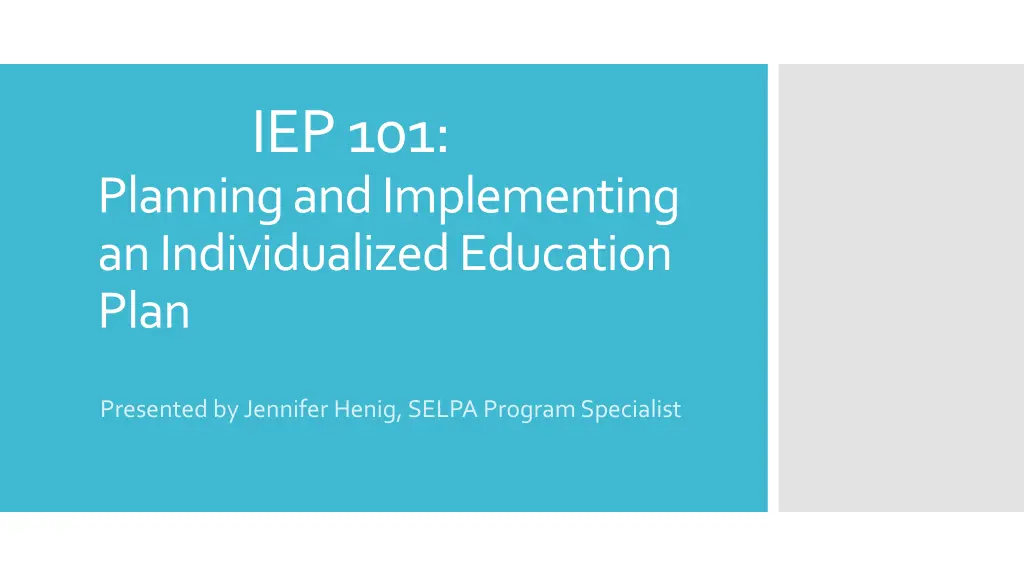
Understanding Different Types of Disabilities in Education
Learn about various disabilities in education, including autism, deaf-blindness, emotional disturbance, and hearing impairment. Understand the characteristics, impact on educational performance, and eligibility criteria under the Individuals with Disabilities Education Act (IDEA).
Download Presentation

Please find below an Image/Link to download the presentation.
The content on the website is provided AS IS for your information and personal use only. It may not be sold, licensed, or shared on other websites without obtaining consent from the author. If you encounter any issues during the download, it is possible that the publisher has removed the file from their server.
You are allowed to download the files provided on this website for personal or commercial use, subject to the condition that they are used lawfully. All files are the property of their respective owners.
The content on the website is provided AS IS for your information and personal use only. It may not be sold, licensed, or shared on other websites without obtaining consent from the author.
E N D
Presentation Transcript
IEP 101: Planning and Implementing an Individualized Education Plan Presented by Jennifer Henig, SELPA Program Specialist
Suspected Disability (SST/504/Referral) Primary Disability Secondary Disability Assessment Goals and Benchmarks Effects of Disability Related Services and Supports Free and Appropriate Education
Autism Autism means a developmental disability significantly affecting verbal and nonverbal communication and social interaction, generally evident before age three, which adversely affects a child's educational performance. Other characteristics often associated with autism are engagement in repetitive activities and stereotyped movements, resistance to environmental change or change in daily routines, and unusual responses to sensory experiences. Autism does not apply if a child's educational performance is adversely affected primarily because the child has an emotional disturbance. A child who manifests the characteristics of autism after age three could be identified as having autism. 13 areas of qualifying disability
Deaf-blindness Deaf-blindness means concomitant hearing and visual impairments, the combination of which causes such severe communication and other developmental and educational needs that they cannot be accommodated in special education programs solely for children with deafness or children with blindness. 13 areas of qualifying disability Deafness Deafness means a hearing impairment that is so severe that the child is impaired in processing linguistic information through hearing, with or without amplification that adversely affects a child's educational performance.
Emotional Disturbance Emotional disturbance means a condition exhibiting one or more of the following characteristics over a long period of time and to a marked degree that adversely affects a child's educational performance: o An inability to learn that cannot be explained by intellectual, sensory, or health factors. o An inability to build or maintain satisfactory interpersonal relationships with peers and teachers. o Inappropriate types of behavior or feelings under normal circumstances. Inappropriate types of behavior or feelings under normal circumstances. o A general pervasive mood of unhappiness or depression. o A tendency to develop physical symptoms or fears associated with personal or school problems. 13 areas of qualifying disability Emotional disturbance includes schizophrenia. The term does not apply to children who are socially maladjusted, unless it is determined that they have an emotional disturbance.
Hearing impairment Hearing impairment means an impairment in hearing, whether permanent or fluctuating, that adversely affects a child's educational performance but that is not included under the definition of deafness. 13 areas of qualifying disability Intellectual Disability Intellectual Disability means significantly sub-average general intellectual functioning, existing concurrently with deficits in communicative and adaptive behavior and manifested during the developmental period, which adversely affects a child's educational performance.
Multiple disabilities Multiple disabilities means concomitant impairments (such as intellectual disability-blindness or intellectual disability-orthopedic impairment), the combination of which causes such severe educational needs that they cannot be accommodated in special education programs solely for one of the impairments. Multiple disabilities do not include deaf-blindness. 13 areas of qualifying disability Orthopedic impairment Orthopedic impairment means a severe orthopedic impairment that adversely affects a child s educational performance. The term includes impairments caused by a congenital anomaly, impairments caused by disease (e.g., poliomyelitis, bone tuberculosis), and impairments from other causes (e.g., cerebral palsy, amputations, and fractures or burns that cause contractures).
Other health impairment Other health impairment means having limited strength, vitality, or alertness, including a heightened alertness to environmental stimuli, that results in limited alertness with respect to the educational environment, that-- o Is due to chronic or acute health problems such as asthma, attention deficit disorder or attention deficit hyperactivity disorder, diabetes, epilepsy, a heart condition, hemophilia, lead poisoning, leukemia, nephritis, rheumatic fever, sickle cell anemia, and Tourettes syndrome; and o Adversely affects a child's educational performance 13 areas of qualifying disability
Specific Learning Disability Specific learning disability means a disorder in one or more of the basic psychological processes involved in understanding or in using language, spoken or written, that may manifest itself in the imperfect ability to listen, think, speak, read, write, spell, or to do mathematical calculations. o Conditions include perceptual disabilities, brain injury, minimal brain dysfunction, dyslexia, and developmental aphasia. Specific learning disability does not include learning problems that are primarily the result of visual, hearing, or motor disabilities, of intellectual disability, of emotional disturbance, or of environmental, cultural, or economic disadvantage. 13 areas of qualifying disability
Speech or Language Impairment Speech or Language Impairment means a communication disorder, such as stuttering, impaired articulation, language impairment, or a voice impairment, that adversely affects a child's educational performance. Traumatic brain injury Traumatic brain injury (TBI) means an acquired injury to the brain caused by an external physical force, resulting in total or partial functional disability or psychosocial impairment, or both, that adversely affects a child's educational performance. Traumatic brain injury applies to open or closed head injuries resulting in impairments in one or more areas, such as cognition; language; memory; attention; reasoning; abstract thinking; judgment; problem-solving; sensory, perceptual, and motor abilities; psychosocial behavior; physical functions; information processing; and speech. Traumatic brain injury does not apply to brain injuries that are congenital or degenerative, or to brain injuries induced by birth trauma. 13 areas of qualifying disability Visual impairment Visual Impairment including blindness means an impairment in vision that, even with correction, adversely affects a child's educational performance. The term includes both partial sight and blindness.
The meeting vs. the document Pre-planning Conducting Implementing Follow-up/Tips Translation Preparing and Conducting an IEP: Stages
The IEP should be at a time and on a date that can accommodate as many of the IEP team members as possible: parents, teachers, administration and other agencies (i.e. SARC, Mental Health, Social Workers, Probation, etc.). Students over the age of 14 must attend their IEP (unless the parent excuses the student from the IEP); Case managers should meet with student to begin narrowing transition plan and goals, as well as giving a student a quick review Preparing and Conducting an IEP: Pre-Planning Best practice is to work with parents and have elementary and junior high students attend their IEPs when appropriate. Case managers need to alert participants of time and date of meeting as well as send out and receive progress reports. A staffing can be held to prepare for an IEP, but this does not serve as an IEP Meeting, draft IEP documents can come out of a staffing. Agenda should be created with a purpose of meeting
Introduction of all team members and review of purpose and the process of an IEP meeting Pass out the agenda and state length of time for meeting; offer parents a copy of their Procedural Safeguards Review assessments, if applicable Determine eligibility, initial or continuing Identify strengths and parent concerns, as well as areas of need ( i.e. academic, social/emotional, transitional, daily living, etc.). Develop goals and objectives/benchmarks that address identified needs (including transitional goals for students over the age of 14); Develop behavior goals or behavior intervention as needed. Identify designated instructional services necessary for the student to benefit from the educational program and the amount, location and frequency of services that the student will receive Identify programs where goals and objectives/IEP can be implemented in the least restrictive environment put all options discussed in writing on the IEP ( programs and services considered ). Summarize decisions of team signatures and conclude meeting. If needed set a date and time for the next meeting. Preparing and Conducting an IEP: IEP
A legally defensible IEP includes: Eligibility Effects of Disability Parent Input Present Levels of Performance Preparing and Conducting an IEP: Elements of an IEP Instructional Accommodations and Modifications Goals Related Services and Supports (Extended School Year) Transition Plan (14+) Offer of Free and Appropriate Public Education (FAPE) Signatures
Case managers must make sure the IEP is processed and sent home for parents/guardian. Case manager needs to review notes from IEP and make sure that follow through is occurring (i.e. Chem teacher is sending home weekly updates, social worker is investigating a new therapist, parents taking student to an optometrist). Preparing and Conducting an IEP: Implementation Case manager may need to make ongoing contacts, always record consulting and planning and follow-up conversations. Case manager may want to meet with a few of the team members to review and de-brief after the IEP; reflecting on what went well, what needs to be reviewed or changed for the next IEP. Team should continue to be in contact after the meeting and will always want to refer back to the IEP meeting and agreements during the implementation process.
Remember that many members of the IEP may not be familiar with terminology or jargon relating to Special Education keep language understandable, but if you must use terminology make sure that you clarify for all team members. An IEP should start and end at the designated time; if time runs out and agenda items still need to be completed , then consult with team for an extension or the IEP can be rescheduled for another time and date. Note: case manager must take into consideration timeliness, and plan accordingly. Preparing and Conducting an IEP: Additional IEP tips If an IEP team member begins to feel uncomfortable with the turn the IEP is taking ( for example, marked hostility, inappropriate language, etc.) it is appropriate to take a break. And, it can at times be appropriate to ask that the team conclude the meeting and meet at anther time, especially if an administrator or their designee was not able to be in attendance.
Highlight collaboration as an IEP team (one of the reasons pre- planning is so important); all members of the team are essential to creating an effective IEP that idea and mood should be pervasive throughout the entire meeting. It is important to utilize team members underlying interests to move from competition into collaboration, while maintaining a strong and positive team spirit. Consider the emotional element of an IEP; examine the role of feeling and emotions as motivators of behavior. Avoid using accusatory language, such as, your agency never called me back. Instead use a neutral tone and state the problem, without assigning blame, while offering a forum for resolution, at the last meeting there was an agreement that Mental Health would contact the case manager on a weekly basis. I know that everyone is busy, but what can we do as a team to meet this expectation of the IEP. Let s consider some suggestions Finally, remember that the IEP is created for the student . Whether a student participates and regardless of the age of the student, a student should feel like they are always part of the team. Preparing and Conducting an IEP: Additional IEP tips
If the IEP needs to be translated meet with the translator prior to meeting to review purpose of meeting, as well as the format and process of the IEP; Key terminology should be reviewed and identified. If the student is not familiar with the student, review some background information with the translator (as pertains to the IEP)so that he/she will have sense of the IEP and the individuals involved. Preparing and Conducting an IEP: Translation If an IEP is being translated for a parent/guardian al team members should address questions and comments to the parent/guardian. Don t get into the routine of saying things such as, Tell Mrs. Lopez that Jose is doing well in math. Speak directly to the parent/guardian.
Acronym List IQ - Intelligence Quotient LD - Learning Disabilities LEP - Limited-English-Proficient LRE - Least Restrictive Environment OH-Orthopedically Handicapped OHI-Other Heath Impaired OT-Occupational Therapy O&M-Orientation and Mobility PDD - Pervasive Developmental Disorders RSP-Resource Specialist Program SDC-Special Day Class SELPA-Special Education Local Plan Area SH-Severely Handicapped SLD-Specific Learning Disability SST-Student Study Team TBI - Traumatic Brain Injury VI - Visually Impaired ADA - Americans with Disabilities Act ADD - Attention Deficit Disorder ADHD - Attention Deficit Hyperactive Disorder ASL - American Sign Language AT - Assistive Technology BIP - Behavioral Intervention Plan CEC - Council for Exceptional Children ED- Emotionally Disabled ELL- English Language Learner ERMHS-Educationally Related Mental Health Services ESL - English as a Second Language FAPE - Free and Appropriate Public Education FBA - Functional Behavioral Assessment HI - Hearing Impaired HOH-Hard of Hearing IDEA - Individuals with Disabilities Education Act IEP - Individualized Education Program (sometimes called Individualized Education Plan)
Further questions regarding IEPs and/or SELPA Professional Development? Thank You! Contact: Jennifer Henig, SELPA Program Specialist 831-637-9269 x312 Your Attendance and Support is Appreciated! Or jhenig@sbcoe.og

